Business Communication Competence: Self-Perception and Development
VerifiedAdded on 2023/06/11
|17
|5151
|498
Essay
AI Summary
This essay delves into the importance of effective business communication, beginning with a self-assessment using the Self-Perceived Communication Competence (SPCC) scale, which measures various aspects of communication across different contexts. The author reflects on their scores in verbal communication, non-verbal immediacy, intercultural communication apprehension, talkativeness, and tolerance for disagreement, identifying areas for improvement, particularly in verbal communication and intercultural interactions. The essay further analyzes two professional experiences: one involving a failed presentation due to ineffective message delivery and another concerning communication challenges with a foreign expert, highlighting the importance of cultural awareness and adaptive communication strategies. The author emphasizes the role of Willingness to Communicate (WTC) and intercultural communication in multicultural environments, outlining key factors affecting communication with individuals from different cultures and suggesting strategies for improvement, such as seeking guidance from experienced professionals, practicing foreign languages, and engaging in cultural awareness training. The essay concludes by underscoring the significance of effective communication processes and the need for continuous development of communication skills in diverse professional settings. Desklib provides students with access to past papers and solved assignments to aid in their studies.
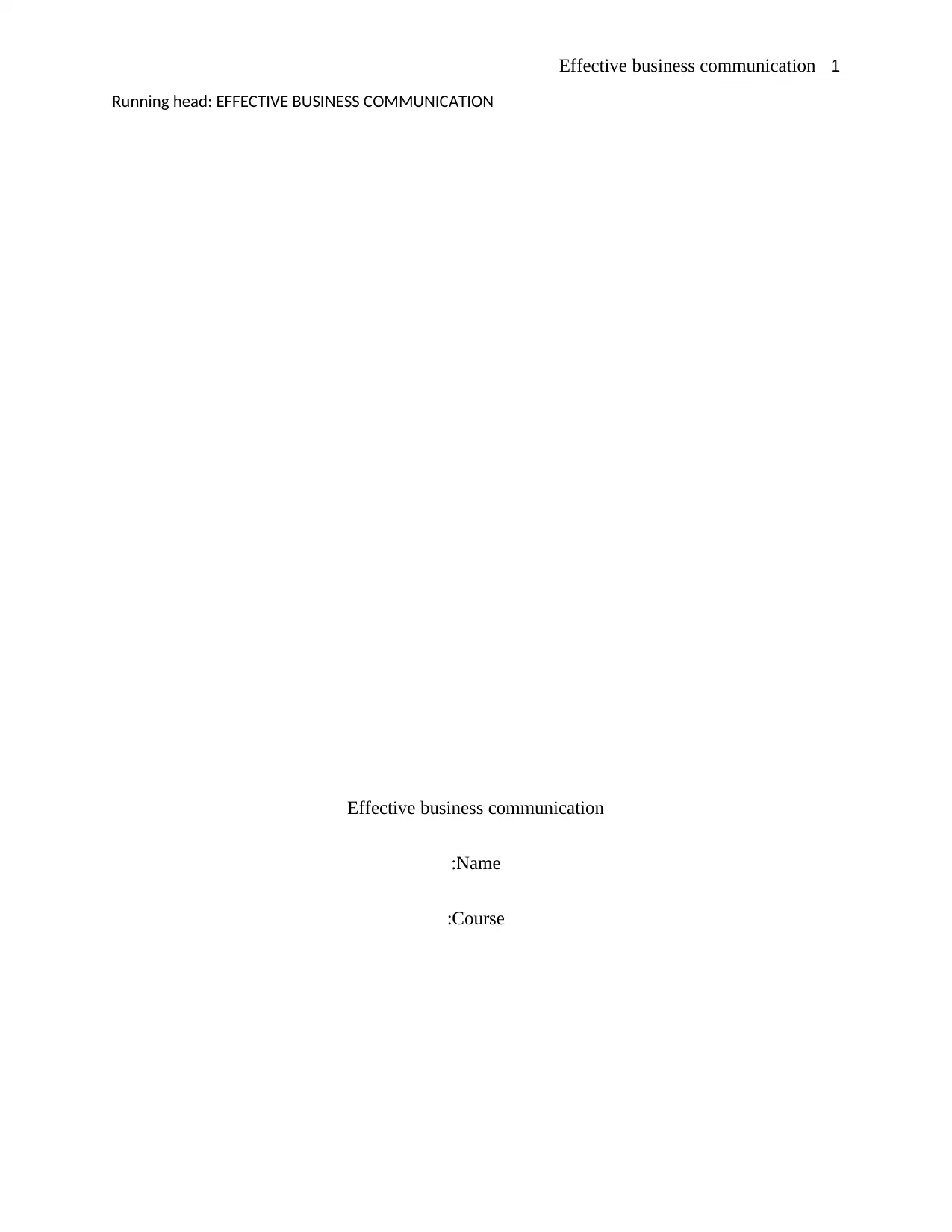
1Effective business communication
Running head: EFFECTIVE BUSINESS COMMUNICATION
Effective business communication
Name:
Course:
Running head: EFFECTIVE BUSINESS COMMUNICATION
Effective business communication
Name:
Course:
Paraphrase This Document
Need a fresh take? Get an instant paraphrase of this document with our AI Paraphraser
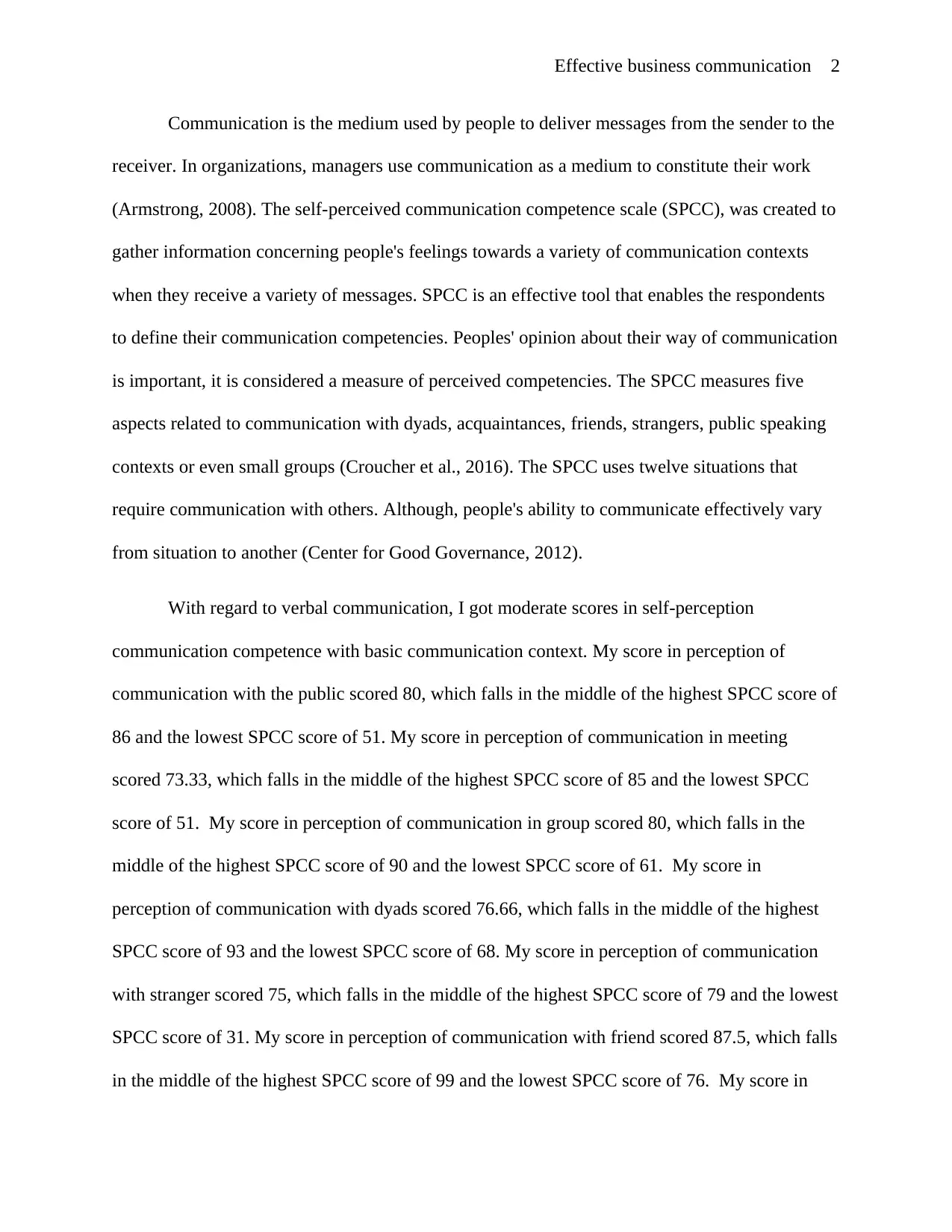
2Effective business communication
Communication is the medium used by people to deliver messages from the sender to the
receiver. In organizations, managers use communication as a medium to constitute their work
(Armstrong, 2008). The self-perceived communication competence scale (SPCC), was created to
gather information concerning people's feelings towards a variety of communication contexts
when they receive a variety of messages. SPCC is an effective tool that enables the respondents
to define their communication competencies. Peoples' opinion about their way of communication
is important, it is considered a measure of perceived competencies. The SPCC measures five
aspects related to communication with dyads, acquaintances, friends, strangers, public speaking
contexts or even small groups (Croucher et al., 2016). The SPCC uses twelve situations that
require communication with others. Although, people's ability to communicate effectively vary
from situation to another (Center for Good Governance, 2012).
With regard to verbal communication, I got moderate scores in self-perception
communication competence with basic communication context. My score in perception of
communication with the public scored 80, which falls in the middle of the highest SPCC score of
86 and the lowest SPCC score of 51. My score in perception of communication in meeting
scored 73.33, which falls in the middle of the highest SPCC score of 85 and the lowest SPCC
score of 51. My score in perception of communication in group scored 80, which falls in the
middle of the highest SPCC score of 90 and the lowest SPCC score of 61. My score in
perception of communication with dyads scored 76.66, which falls in the middle of the highest
SPCC score of 93 and the lowest SPCC score of 68. My score in perception of communication
with stranger scored 75, which falls in the middle of the highest SPCC score of 79 and the lowest
SPCC score of 31. My score in perception of communication with friend scored 87.5, which falls
in the middle of the highest SPCC score of 99 and the lowest SPCC score of 76. My score in
Communication is the medium used by people to deliver messages from the sender to the
receiver. In organizations, managers use communication as a medium to constitute their work
(Armstrong, 2008). The self-perceived communication competence scale (SPCC), was created to
gather information concerning people's feelings towards a variety of communication contexts
when they receive a variety of messages. SPCC is an effective tool that enables the respondents
to define their communication competencies. Peoples' opinion about their way of communication
is important, it is considered a measure of perceived competencies. The SPCC measures five
aspects related to communication with dyads, acquaintances, friends, strangers, public speaking
contexts or even small groups (Croucher et al., 2016). The SPCC uses twelve situations that
require communication with others. Although, people's ability to communicate effectively vary
from situation to another (Center for Good Governance, 2012).
With regard to verbal communication, I got moderate scores in self-perception
communication competence with basic communication context. My score in perception of
communication with the public scored 80, which falls in the middle of the highest SPCC score of
86 and the lowest SPCC score of 51. My score in perception of communication in meeting
scored 73.33, which falls in the middle of the highest SPCC score of 85 and the lowest SPCC
score of 51. My score in perception of communication in group scored 80, which falls in the
middle of the highest SPCC score of 90 and the lowest SPCC score of 61. My score in
perception of communication with dyads scored 76.66, which falls in the middle of the highest
SPCC score of 93 and the lowest SPCC score of 68. My score in perception of communication
with stranger scored 75, which falls in the middle of the highest SPCC score of 79 and the lowest
SPCC score of 31. My score in perception of communication with friend scored 87.5, which falls
in the middle of the highest SPCC score of 99 and the lowest SPCC score of 76. My score in
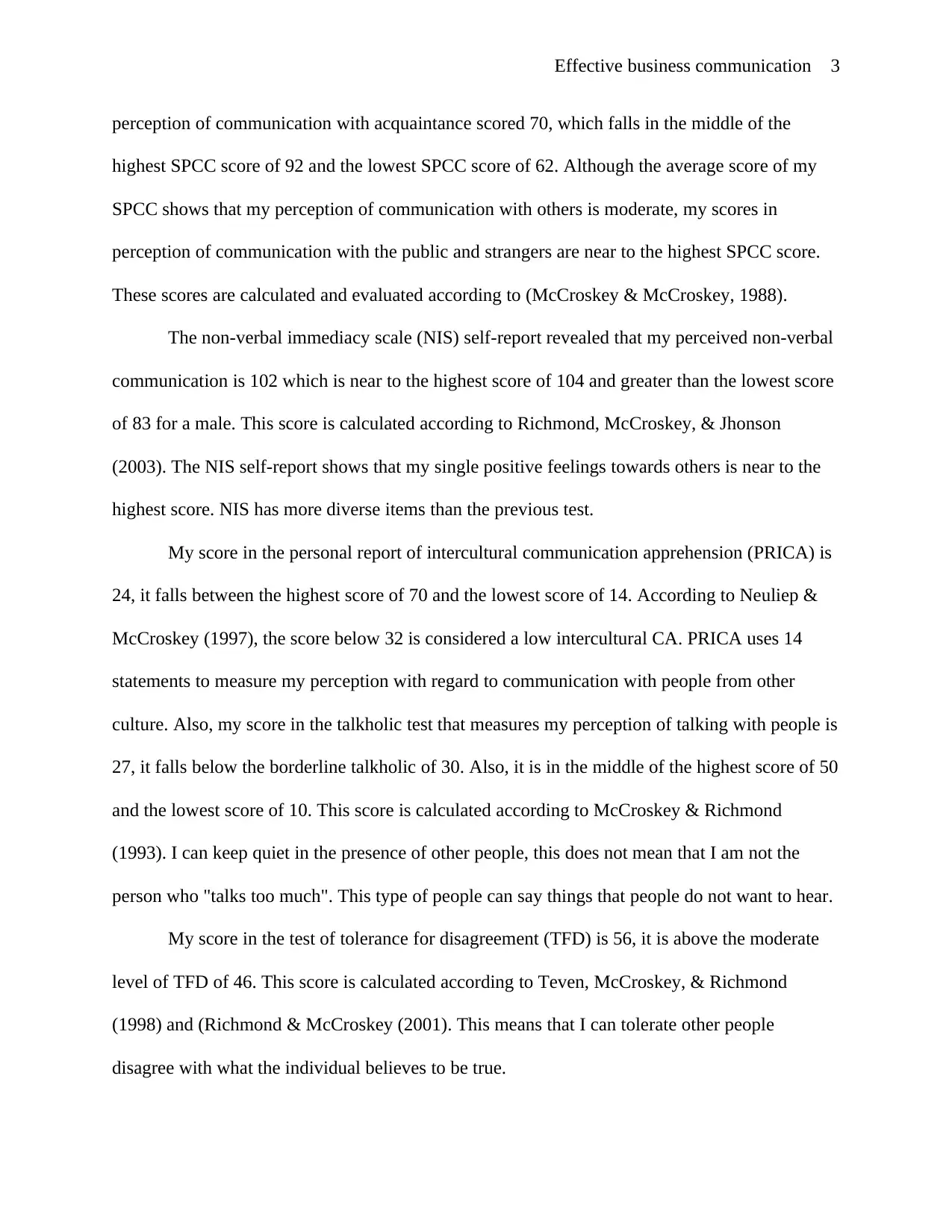
3Effective business communication
perception of communication with acquaintance scored 70, which falls in the middle of the
highest SPCC score of 92 and the lowest SPCC score of 62. Although the average score of my
SPCC shows that my perception of communication with others is moderate, my scores in
perception of communication with the public and strangers are near to the highest SPCC score.
These scores are calculated and evaluated according to (McCroskey & McCroskey, 1988).
The non-verbal immediacy scale (NIS) self-report revealed that my perceived non-verbal
communication is 102 which is near to the highest score of 104 and greater than the lowest score
of 83 for a male. This score is calculated according to Richmond, McCroskey, & Jhonson
(2003). The NIS self-report shows that my single positive feelings towards others is near to the
highest score. NIS has more diverse items than the previous test.
My score in the personal report of intercultural communication apprehension (PRICA) is
24, it falls between the highest score of 70 and the lowest score of 14. According to Neuliep &
McCroskey (1997), the score below 32 is considered a low intercultural CA. PRICA uses 14
statements to measure my perception with regard to communication with people from other
culture. Also, my score in the talkholic test that measures my perception of talking with people is
27, it falls below the borderline talkholic of 30. Also, it is in the middle of the highest score of 50
and the lowest score of 10. This score is calculated according to McCroskey & Richmond
(1993). I can keep quiet in the presence of other people, this does not mean that I am not the
person who "talks too much". This type of people can say things that people do not want to hear.
My score in the test of tolerance for disagreement (TFD) is 56, it is above the moderate
level of TFD of 46. This score is calculated according to Teven, McCroskey, & Richmond
(1998) and (Richmond & McCroskey (2001). This means that I can tolerate other people
disagree with what the individual believes to be true.
perception of communication with acquaintance scored 70, which falls in the middle of the
highest SPCC score of 92 and the lowest SPCC score of 62. Although the average score of my
SPCC shows that my perception of communication with others is moderate, my scores in
perception of communication with the public and strangers are near to the highest SPCC score.
These scores are calculated and evaluated according to (McCroskey & McCroskey, 1988).
The non-verbal immediacy scale (NIS) self-report revealed that my perceived non-verbal
communication is 102 which is near to the highest score of 104 and greater than the lowest score
of 83 for a male. This score is calculated according to Richmond, McCroskey, & Jhonson
(2003). The NIS self-report shows that my single positive feelings towards others is near to the
highest score. NIS has more diverse items than the previous test.
My score in the personal report of intercultural communication apprehension (PRICA) is
24, it falls between the highest score of 70 and the lowest score of 14. According to Neuliep &
McCroskey (1997), the score below 32 is considered a low intercultural CA. PRICA uses 14
statements to measure my perception with regard to communication with people from other
culture. Also, my score in the talkholic test that measures my perception of talking with people is
27, it falls below the borderline talkholic of 30. Also, it is in the middle of the highest score of 50
and the lowest score of 10. This score is calculated according to McCroskey & Richmond
(1993). I can keep quiet in the presence of other people, this does not mean that I am not the
person who "talks too much". This type of people can say things that people do not want to hear.
My score in the test of tolerance for disagreement (TFD) is 56, it is above the moderate
level of TFD of 46. This score is calculated according to Teven, McCroskey, & Richmond
(1998) and (Richmond & McCroskey (2001). This means that I can tolerate other people
disagree with what the individual believes to be true.
⊘ This is a preview!⊘
Do you want full access?
Subscribe today to unlock all pages.

Trusted by 1+ million students worldwide
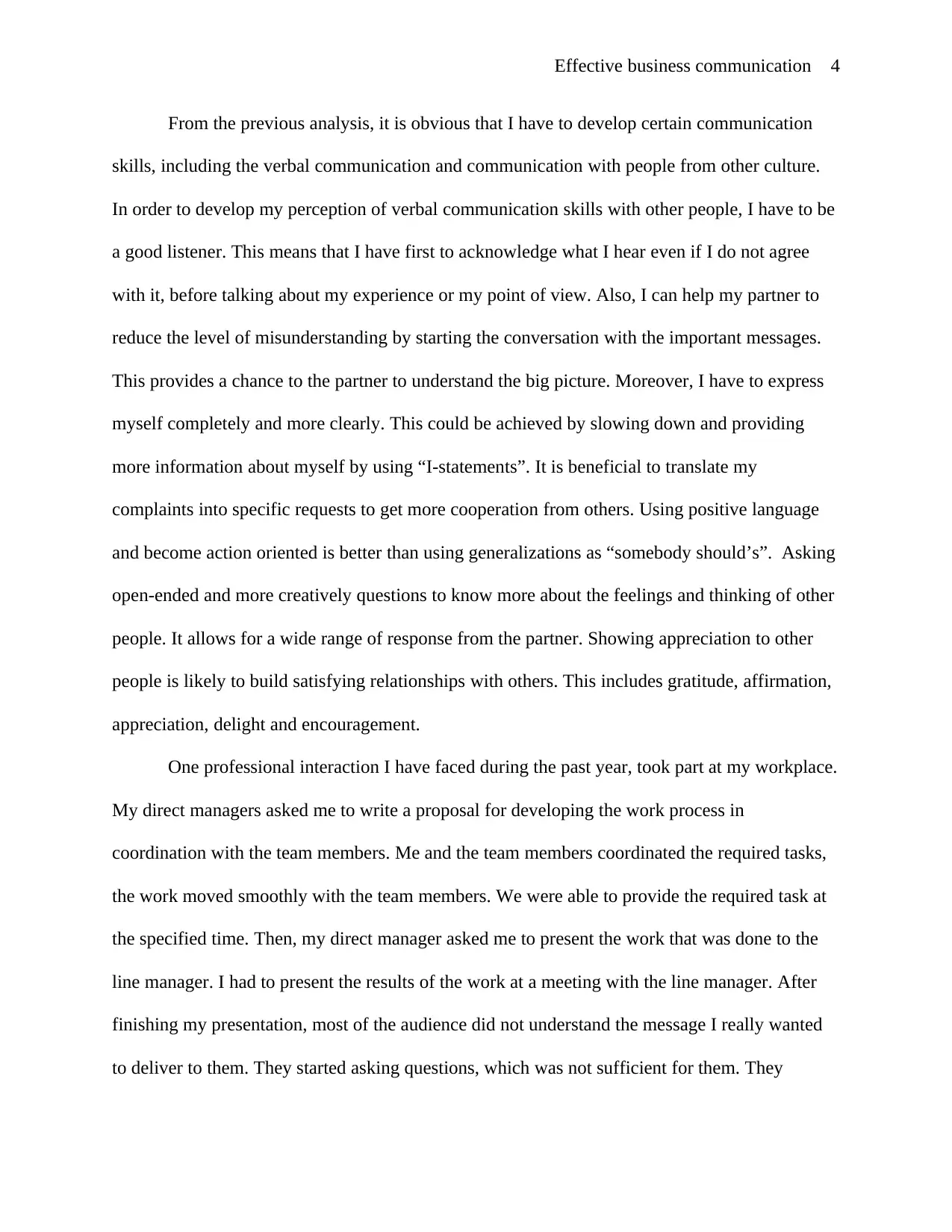
4Effective business communication
From the previous analysis, it is obvious that I have to develop certain communication
skills, including the verbal communication and communication with people from other culture.
In order to develop my perception of verbal communication skills with other people, I have to be
a good listener. This means that I have first to acknowledge what I hear even if I do not agree
with it, before talking about my experience or my point of view. Also, I can help my partner to
reduce the level of misunderstanding by starting the conversation with the important messages.
This provides a chance to the partner to understand the big picture. Moreover, I have to express
myself completely and more clearly. This could be achieved by slowing down and providing
more information about myself by using “I-statements”. It is beneficial to translate my
complaints into specific requests to get more cooperation from others. Using positive language
and become action oriented is better than using generalizations as “somebody should’s”. Asking
open-ended and more creatively questions to know more about the feelings and thinking of other
people. It allows for a wide range of response from the partner. Showing appreciation to other
people is likely to build satisfying relationships with others. This includes gratitude, affirmation,
appreciation, delight and encouragement.
One professional interaction I have faced during the past year, took part at my workplace.
My direct managers asked me to write a proposal for developing the work process in
coordination with the team members. Me and the team members coordinated the required tasks,
the work moved smoothly with the team members. We were able to provide the required task at
the specified time. Then, my direct manager asked me to present the work that was done to the
line manager. I had to present the results of the work at a meeting with the line manager. After
finishing my presentation, most of the audience did not understand the message I really wanted
to deliver to them. They started asking questions, which was not sufficient for them. They
From the previous analysis, it is obvious that I have to develop certain communication
skills, including the verbal communication and communication with people from other culture.
In order to develop my perception of verbal communication skills with other people, I have to be
a good listener. This means that I have first to acknowledge what I hear even if I do not agree
with it, before talking about my experience or my point of view. Also, I can help my partner to
reduce the level of misunderstanding by starting the conversation with the important messages.
This provides a chance to the partner to understand the big picture. Moreover, I have to express
myself completely and more clearly. This could be achieved by slowing down and providing
more information about myself by using “I-statements”. It is beneficial to translate my
complaints into specific requests to get more cooperation from others. Using positive language
and become action oriented is better than using generalizations as “somebody should’s”. Asking
open-ended and more creatively questions to know more about the feelings and thinking of other
people. It allows for a wide range of response from the partner. Showing appreciation to other
people is likely to build satisfying relationships with others. This includes gratitude, affirmation,
appreciation, delight and encouragement.
One professional interaction I have faced during the past year, took part at my workplace.
My direct managers asked me to write a proposal for developing the work process in
coordination with the team members. Me and the team members coordinated the required tasks,
the work moved smoothly with the team members. We were able to provide the required task at
the specified time. Then, my direct manager asked me to present the work that was done to the
line manager. I had to present the results of the work at a meeting with the line manager. After
finishing my presentation, most of the audience did not understand the message I really wanted
to deliver to them. They started asking questions, which was not sufficient for them. They
Paraphrase This Document
Need a fresh take? Get an instant paraphrase of this document with our AI Paraphraser
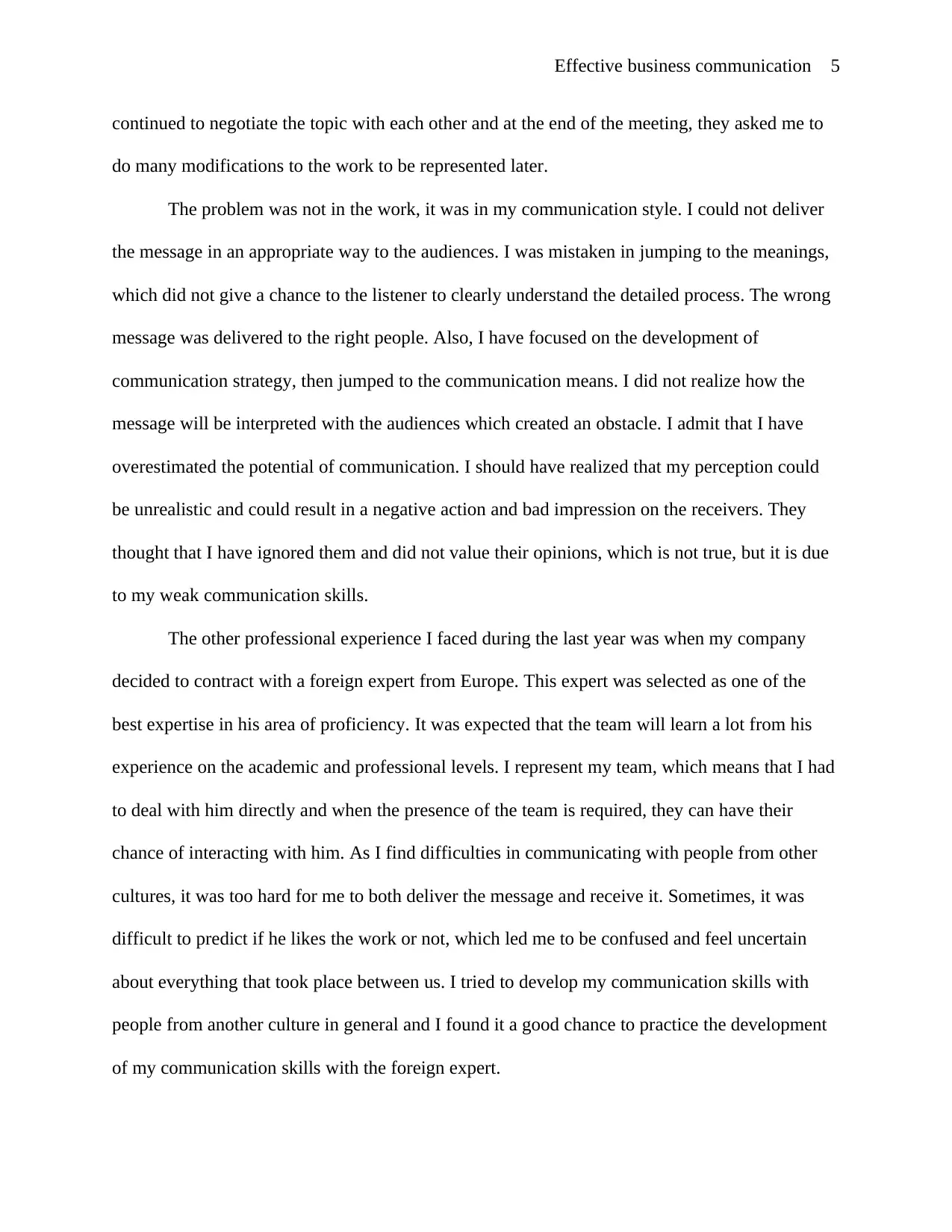
5Effective business communication
continued to negotiate the topic with each other and at the end of the meeting, they asked me to
do many modifications to the work to be represented later.
The problem was not in the work, it was in my communication style. I could not deliver
the message in an appropriate way to the audiences. I was mistaken in jumping to the meanings,
which did not give a chance to the listener to clearly understand the detailed process. The wrong
message was delivered to the right people. Also, I have focused on the development of
communication strategy, then jumped to the communication means. I did not realize how the
message will be interpreted with the audiences which created an obstacle. I admit that I have
overestimated the potential of communication. I should have realized that my perception could
be unrealistic and could result in a negative action and bad impression on the receivers. They
thought that I have ignored them and did not value their opinions, which is not true, but it is due
to my weak communication skills.
The other professional experience I faced during the last year was when my company
decided to contract with a foreign expert from Europe. This expert was selected as one of the
best expertise in his area of proficiency. It was expected that the team will learn a lot from his
experience on the academic and professional levels. I represent my team, which means that I had
to deal with him directly and when the presence of the team is required, they can have their
chance of interacting with him. As I find difficulties in communicating with people from other
cultures, it was too hard for me to both deliver the message and receive it. Sometimes, it was
difficult to predict if he likes the work or not, which led me to be confused and feel uncertain
about everything that took place between us. I tried to develop my communication skills with
people from another culture in general and I found it a good chance to practice the development
of my communication skills with the foreign expert.
continued to negotiate the topic with each other and at the end of the meeting, they asked me to
do many modifications to the work to be represented later.
The problem was not in the work, it was in my communication style. I could not deliver
the message in an appropriate way to the audiences. I was mistaken in jumping to the meanings,
which did not give a chance to the listener to clearly understand the detailed process. The wrong
message was delivered to the right people. Also, I have focused on the development of
communication strategy, then jumped to the communication means. I did not realize how the
message will be interpreted with the audiences which created an obstacle. I admit that I have
overestimated the potential of communication. I should have realized that my perception could
be unrealistic and could result in a negative action and bad impression on the receivers. They
thought that I have ignored them and did not value their opinions, which is not true, but it is due
to my weak communication skills.
The other professional experience I faced during the last year was when my company
decided to contract with a foreign expert from Europe. This expert was selected as one of the
best expertise in his area of proficiency. It was expected that the team will learn a lot from his
experience on the academic and professional levels. I represent my team, which means that I had
to deal with him directly and when the presence of the team is required, they can have their
chance of interacting with him. As I find difficulties in communicating with people from other
cultures, it was too hard for me to both deliver the message and receive it. Sometimes, it was
difficult to predict if he likes the work or not, which led me to be confused and feel uncertain
about everything that took place between us. I tried to develop my communication skills with
people from another culture in general and I found it a good chance to practice the development
of my communication skills with the foreign expert.
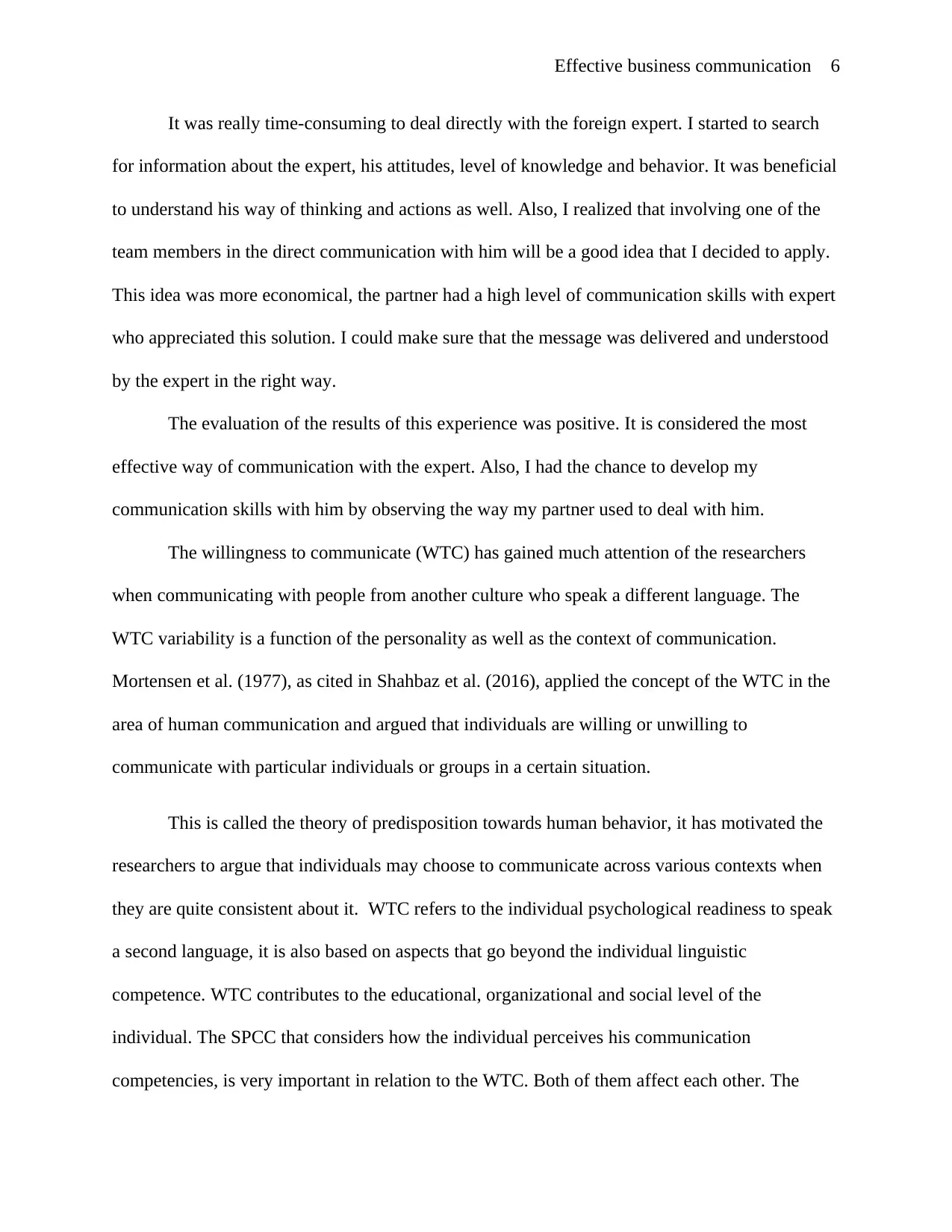
6Effective business communication
It was really time-consuming to deal directly with the foreign expert. I started to search
for information about the expert, his attitudes, level of knowledge and behavior. It was beneficial
to understand his way of thinking and actions as well. Also, I realized that involving one of the
team members in the direct communication with him will be a good idea that I decided to apply.
This idea was more economical, the partner had a high level of communication skills with expert
who appreciated this solution. I could make sure that the message was delivered and understood
by the expert in the right way.
The evaluation of the results of this experience was positive. It is considered the most
effective way of communication with the expert. Also, I had the chance to develop my
communication skills with him by observing the way my partner used to deal with him.
The willingness to communicate (WTC) has gained much attention of the researchers
when communicating with people from another culture who speak a different language. The
WTC variability is a function of the personality as well as the context of communication.
Mortensen et al. (1977), as cited in Shahbaz et al. (2016), applied the concept of the WTC in the
area of human communication and argued that individuals are willing or unwilling to
communicate with particular individuals or groups in a certain situation.
This is called the theory of predisposition towards human behavior, it has motivated the
researchers to argue that individuals may choose to communicate across various contexts when
they are quite consistent about it. WTC refers to the individual psychological readiness to speak
a second language, it is also based on aspects that go beyond the individual linguistic
competence. WTC contributes to the educational, organizational and social level of the
individual. The SPCC that considers how the individual perceives his communication
competencies, is very important in relation to the WTC. Both of them affect each other. The
It was really time-consuming to deal directly with the foreign expert. I started to search
for information about the expert, his attitudes, level of knowledge and behavior. It was beneficial
to understand his way of thinking and actions as well. Also, I realized that involving one of the
team members in the direct communication with him will be a good idea that I decided to apply.
This idea was more economical, the partner had a high level of communication skills with expert
who appreciated this solution. I could make sure that the message was delivered and understood
by the expert in the right way.
The evaluation of the results of this experience was positive. It is considered the most
effective way of communication with the expert. Also, I had the chance to develop my
communication skills with him by observing the way my partner used to deal with him.
The willingness to communicate (WTC) has gained much attention of the researchers
when communicating with people from another culture who speak a different language. The
WTC variability is a function of the personality as well as the context of communication.
Mortensen et al. (1977), as cited in Shahbaz et al. (2016), applied the concept of the WTC in the
area of human communication and argued that individuals are willing or unwilling to
communicate with particular individuals or groups in a certain situation.
This is called the theory of predisposition towards human behavior, it has motivated the
researchers to argue that individuals may choose to communicate across various contexts when
they are quite consistent about it. WTC refers to the individual psychological readiness to speak
a second language, it is also based on aspects that go beyond the individual linguistic
competence. WTC contributes to the educational, organizational and social level of the
individual. The SPCC that considers how the individual perceives his communication
competencies, is very important in relation to the WTC. Both of them affect each other. The
⊘ This is a preview!⊘
Do you want full access?
Subscribe today to unlock all pages.

Trusted by 1+ million students worldwide
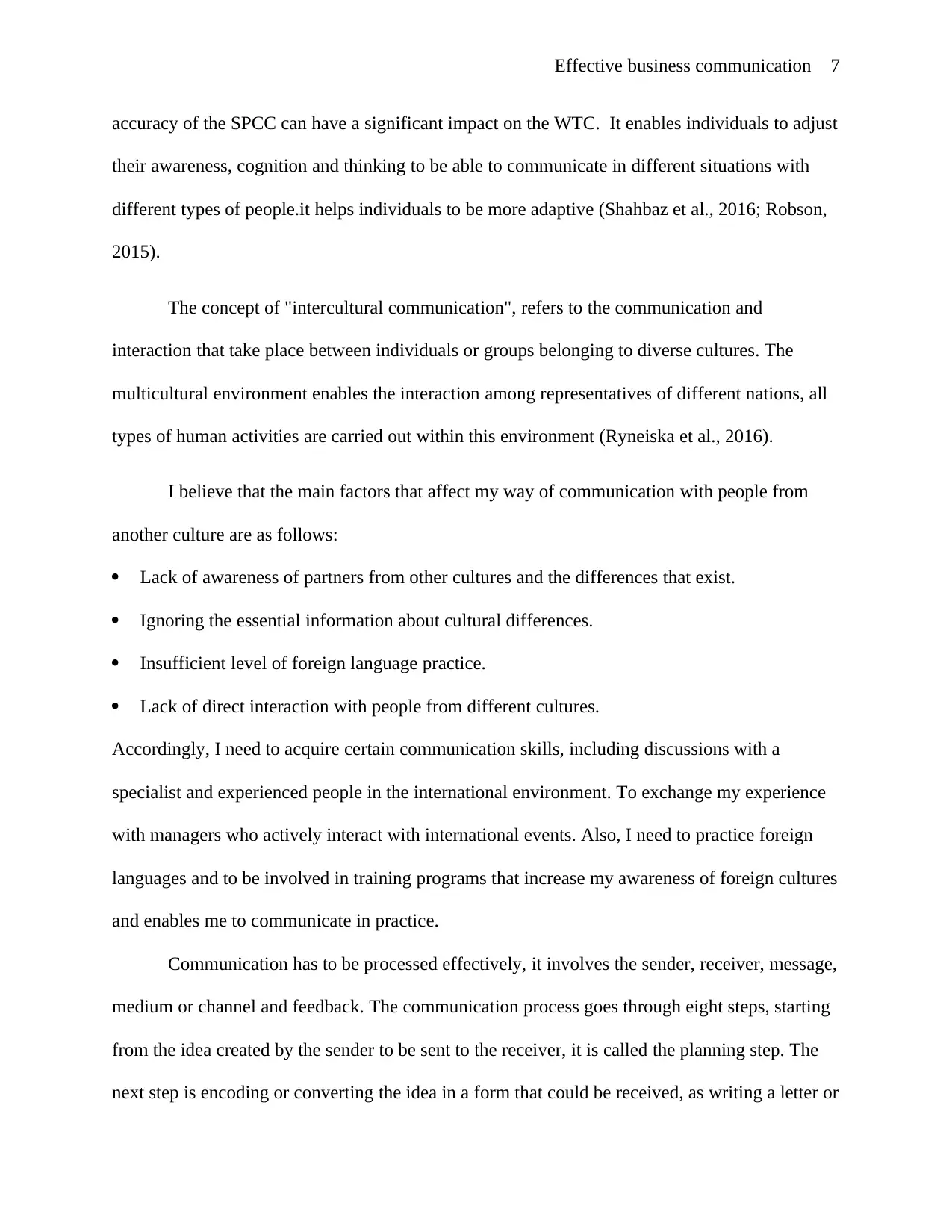
7Effective business communication
accuracy of the SPCC can have a significant impact on the WTC. It enables individuals to adjust
their awareness, cognition and thinking to be able to communicate in different situations with
different types of people.it helps individuals to be more adaptive (Shahbaz et al., 2016; Robson,
2015).
The concept of "intercultural communication", refers to the communication and
interaction that take place between individuals or groups belonging to diverse cultures. The
multicultural environment enables the interaction among representatives of different nations, all
types of human activities are carried out within this environment (Ryneiska et al., 2016).
I believe that the main factors that affect my way of communication with people from
another culture are as follows:
Lack of awareness of partners from other cultures and the differences that exist.
Ignoring the essential information about cultural differences.
Insufficient level of foreign language practice.
Lack of direct interaction with people from different cultures.
Accordingly, I need to acquire certain communication skills, including discussions with a
specialist and experienced people in the international environment. To exchange my experience
with managers who actively interact with international events. Also, I need to practice foreign
languages and to be involved in training programs that increase my awareness of foreign cultures
and enables me to communicate in practice.
Communication has to be processed effectively, it involves the sender, receiver, message,
medium or channel and feedback. The communication process goes through eight steps, starting
from the idea created by the sender to be sent to the receiver, it is called the planning step. The
next step is encoding or converting the idea in a form that could be received, as writing a letter or
accuracy of the SPCC can have a significant impact on the WTC. It enables individuals to adjust
their awareness, cognition and thinking to be able to communicate in different situations with
different types of people.it helps individuals to be more adaptive (Shahbaz et al., 2016; Robson,
2015).
The concept of "intercultural communication", refers to the communication and
interaction that take place between individuals or groups belonging to diverse cultures. The
multicultural environment enables the interaction among representatives of different nations, all
types of human activities are carried out within this environment (Ryneiska et al., 2016).
I believe that the main factors that affect my way of communication with people from
another culture are as follows:
Lack of awareness of partners from other cultures and the differences that exist.
Ignoring the essential information about cultural differences.
Insufficient level of foreign language practice.
Lack of direct interaction with people from different cultures.
Accordingly, I need to acquire certain communication skills, including discussions with a
specialist and experienced people in the international environment. To exchange my experience
with managers who actively interact with international events. Also, I need to practice foreign
languages and to be involved in training programs that increase my awareness of foreign cultures
and enables me to communicate in practice.
Communication has to be processed effectively, it involves the sender, receiver, message,
medium or channel and feedback. The communication process goes through eight steps, starting
from the idea created by the sender to be sent to the receiver, it is called the planning step. The
next step is encoding or converting the idea in a form that could be received, as writing a letter or
Paraphrase This Document
Need a fresh take? Get an instant paraphrase of this document with our AI Paraphraser
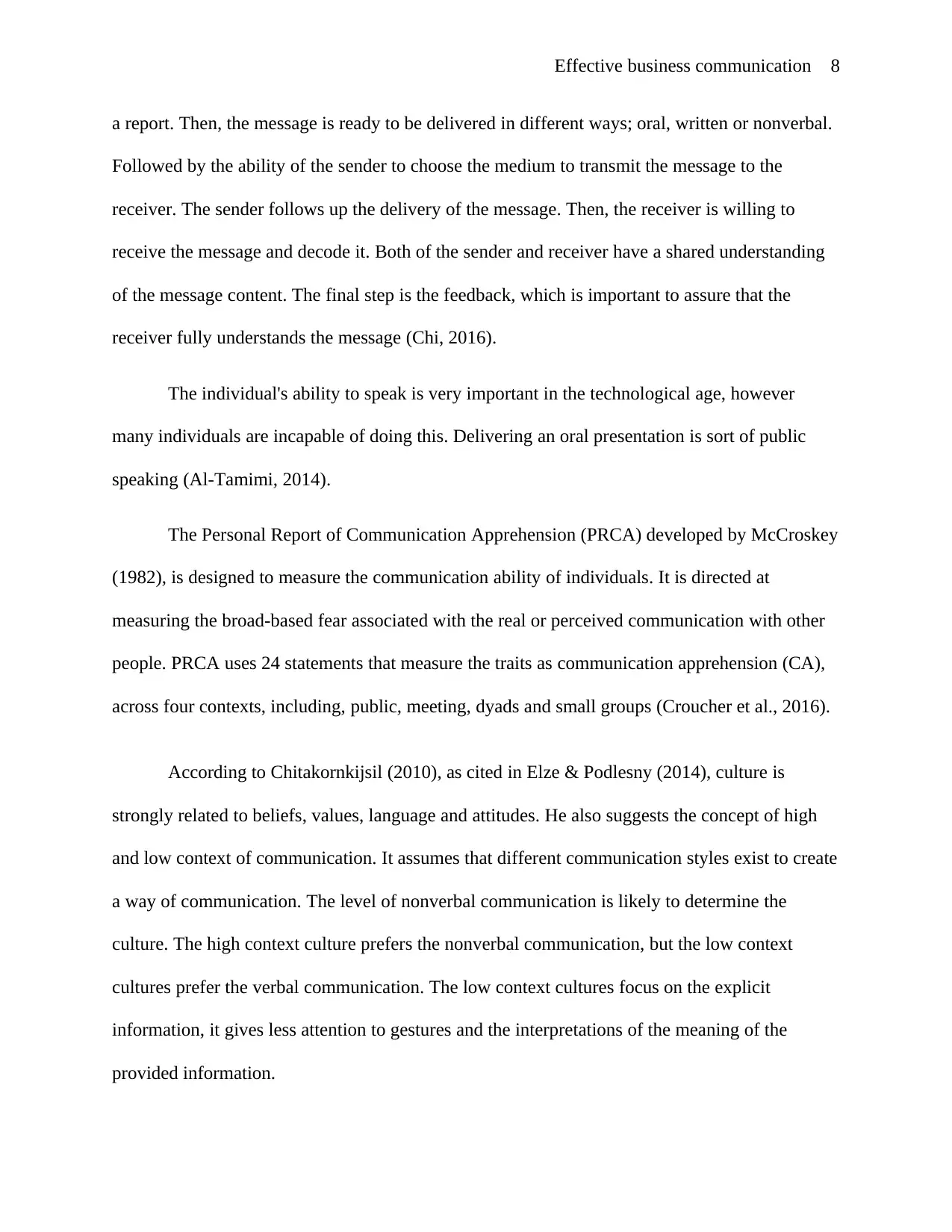
8Effective business communication
a report. Then, the message is ready to be delivered in different ways; oral, written or nonverbal.
Followed by the ability of the sender to choose the medium to transmit the message to the
receiver. The sender follows up the delivery of the message. Then, the receiver is willing to
receive the message and decode it. Both of the sender and receiver have a shared understanding
of the message content. The final step is the feedback, which is important to assure that the
receiver fully understands the message (Chi, 2016).
The individual's ability to speak is very important in the technological age, however
many individuals are incapable of doing this. Delivering an oral presentation is sort of public
speaking (Al-Tamimi, 2014).
The Personal Report of Communication Apprehension (PRCA) developed by McCroskey
(1982), is designed to measure the communication ability of individuals. It is directed at
measuring the broad-based fear associated with the real or perceived communication with other
people. PRCA uses 24 statements that measure the traits as communication apprehension (CA),
across four contexts, including, public, meeting, dyads and small groups (Croucher et al., 2016).
According to Chitakornkijsil (2010), as cited in Elze & Podlesny (2014), culture is
strongly related to beliefs, values, language and attitudes. He also suggests the concept of high
and low context of communication. It assumes that different communication styles exist to create
a way of communication. The level of nonverbal communication is likely to determine the
culture. The high context culture prefers the nonverbal communication, but the low context
cultures prefer the verbal communication. The low context cultures focus on the explicit
information, it gives less attention to gestures and the interpretations of the meaning of the
provided information.
a report. Then, the message is ready to be delivered in different ways; oral, written or nonverbal.
Followed by the ability of the sender to choose the medium to transmit the message to the
receiver. The sender follows up the delivery of the message. Then, the receiver is willing to
receive the message and decode it. Both of the sender and receiver have a shared understanding
of the message content. The final step is the feedback, which is important to assure that the
receiver fully understands the message (Chi, 2016).
The individual's ability to speak is very important in the technological age, however
many individuals are incapable of doing this. Delivering an oral presentation is sort of public
speaking (Al-Tamimi, 2014).
The Personal Report of Communication Apprehension (PRCA) developed by McCroskey
(1982), is designed to measure the communication ability of individuals. It is directed at
measuring the broad-based fear associated with the real or perceived communication with other
people. PRCA uses 24 statements that measure the traits as communication apprehension (CA),
across four contexts, including, public, meeting, dyads and small groups (Croucher et al., 2016).
According to Chitakornkijsil (2010), as cited in Elze & Podlesny (2014), culture is
strongly related to beliefs, values, language and attitudes. He also suggests the concept of high
and low context of communication. It assumes that different communication styles exist to create
a way of communication. The level of nonverbal communication is likely to determine the
culture. The high context culture prefers the nonverbal communication, but the low context
cultures prefer the verbal communication. The low context cultures focus on the explicit
information, it gives less attention to gestures and the interpretations of the meaning of the
provided information.
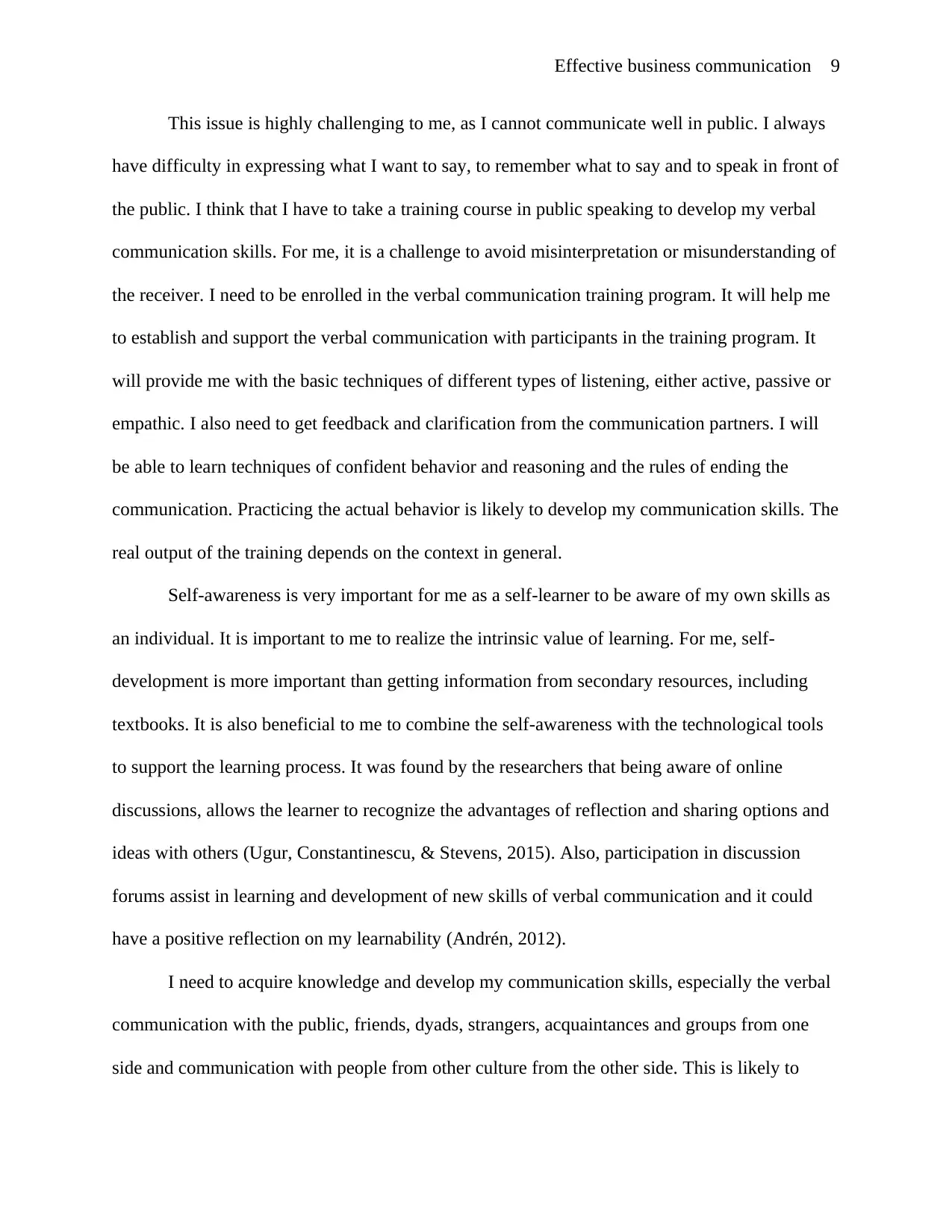
9Effective business communication
This issue is highly challenging to me, as I cannot communicate well in public. I always
have difficulty in expressing what I want to say, to remember what to say and to speak in front of
the public. I think that I have to take a training course in public speaking to develop my verbal
communication skills. For me, it is a challenge to avoid misinterpretation or misunderstanding of
the receiver. I need to be enrolled in the verbal communication training program. It will help me
to establish and support the verbal communication with participants in the training program. It
will provide me with the basic techniques of different types of listening, either active, passive or
empathic. I also need to get feedback and clarification from the communication partners. I will
be able to learn techniques of confident behavior and reasoning and the rules of ending the
communication. Practicing the actual behavior is likely to develop my communication skills. The
real output of the training depends on the context in general.
Self-awareness is very important for me as a self-learner to be aware of my own skills as
an individual. It is important to me to realize the intrinsic value of learning. For me, self-
development is more important than getting information from secondary resources, including
textbooks. It is also beneficial to me to combine the self-awareness with the technological tools
to support the learning process. It was found by the researchers that being aware of online
discussions, allows the learner to recognize the advantages of reflection and sharing options and
ideas with others (Ugur, Constantinescu, & Stevens, 2015). Also, participation in discussion
forums assist in learning and development of new skills of verbal communication and it could
have a positive reflection on my learnability (Andrén, 2012).
I need to acquire knowledge and develop my communication skills, especially the verbal
communication with the public, friends, dyads, strangers, acquaintances and groups from one
side and communication with people from other culture from the other side. This is likely to
This issue is highly challenging to me, as I cannot communicate well in public. I always
have difficulty in expressing what I want to say, to remember what to say and to speak in front of
the public. I think that I have to take a training course in public speaking to develop my verbal
communication skills. For me, it is a challenge to avoid misinterpretation or misunderstanding of
the receiver. I need to be enrolled in the verbal communication training program. It will help me
to establish and support the verbal communication with participants in the training program. It
will provide me with the basic techniques of different types of listening, either active, passive or
empathic. I also need to get feedback and clarification from the communication partners. I will
be able to learn techniques of confident behavior and reasoning and the rules of ending the
communication. Practicing the actual behavior is likely to develop my communication skills. The
real output of the training depends on the context in general.
Self-awareness is very important for me as a self-learner to be aware of my own skills as
an individual. It is important to me to realize the intrinsic value of learning. For me, self-
development is more important than getting information from secondary resources, including
textbooks. It is also beneficial to me to combine the self-awareness with the technological tools
to support the learning process. It was found by the researchers that being aware of online
discussions, allows the learner to recognize the advantages of reflection and sharing options and
ideas with others (Ugur, Constantinescu, & Stevens, 2015). Also, participation in discussion
forums assist in learning and development of new skills of verbal communication and it could
have a positive reflection on my learnability (Andrén, 2012).
I need to acquire knowledge and develop my communication skills, especially the verbal
communication with the public, friends, dyads, strangers, acquaintances and groups from one
side and communication with people from other culture from the other side. This is likely to
⊘ This is a preview!⊘
Do you want full access?
Subscribe today to unlock all pages.

Trusted by 1+ million students worldwide
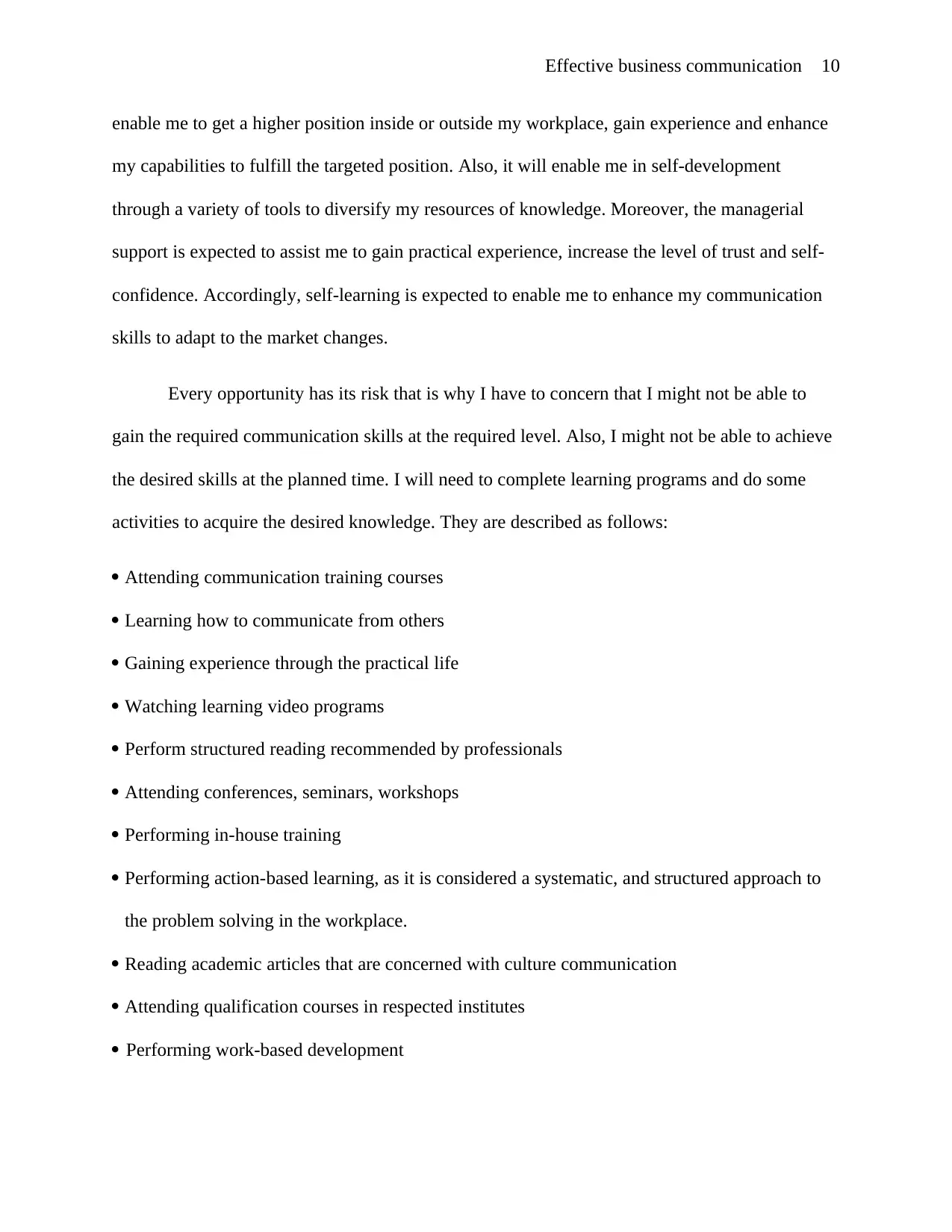
10Effective business communication
enable me to get a higher position inside or outside my workplace, gain experience and enhance
my capabilities to fulfill the targeted position. Also, it will enable me in self-development
through a variety of tools to diversify my resources of knowledge. Moreover, the managerial
support is expected to assist me to gain practical experience, increase the level of trust and self-
confidence. Accordingly, self-learning is expected to enable me to enhance my communication
skills to adapt to the market changes.
Every opportunity has its risk that is why I have to concern that I might not be able to
gain the required communication skills at the required level. Also, I might not be able to achieve
the desired skills at the planned time. I will need to complete learning programs and do some
activities to acquire the desired knowledge. They are described as follows:
Attending communication training courses
Learning how to communicate from others
Gaining experience through the practical life
Watching learning video programs
Perform structured reading recommended by professionals
Attending conferences, seminars, workshops
Performing in-house training
Performing action-based learning, as it is considered a systematic, and structured approach to
the problem solving in the workplace.
Reading academic articles that are concerned with culture communication
Attending qualification courses in respected institutes
Performing work-based development
enable me to get a higher position inside or outside my workplace, gain experience and enhance
my capabilities to fulfill the targeted position. Also, it will enable me in self-development
through a variety of tools to diversify my resources of knowledge. Moreover, the managerial
support is expected to assist me to gain practical experience, increase the level of trust and self-
confidence. Accordingly, self-learning is expected to enable me to enhance my communication
skills to adapt to the market changes.
Every opportunity has its risk that is why I have to concern that I might not be able to
gain the required communication skills at the required level. Also, I might not be able to achieve
the desired skills at the planned time. I will need to complete learning programs and do some
activities to acquire the desired knowledge. They are described as follows:
Attending communication training courses
Learning how to communicate from others
Gaining experience through the practical life
Watching learning video programs
Perform structured reading recommended by professionals
Attending conferences, seminars, workshops
Performing in-house training
Performing action-based learning, as it is considered a systematic, and structured approach to
the problem solving in the workplace.
Reading academic articles that are concerned with culture communication
Attending qualification courses in respected institutes
Performing work-based development
Paraphrase This Document
Need a fresh take? Get an instant paraphrase of this document with our AI Paraphraser
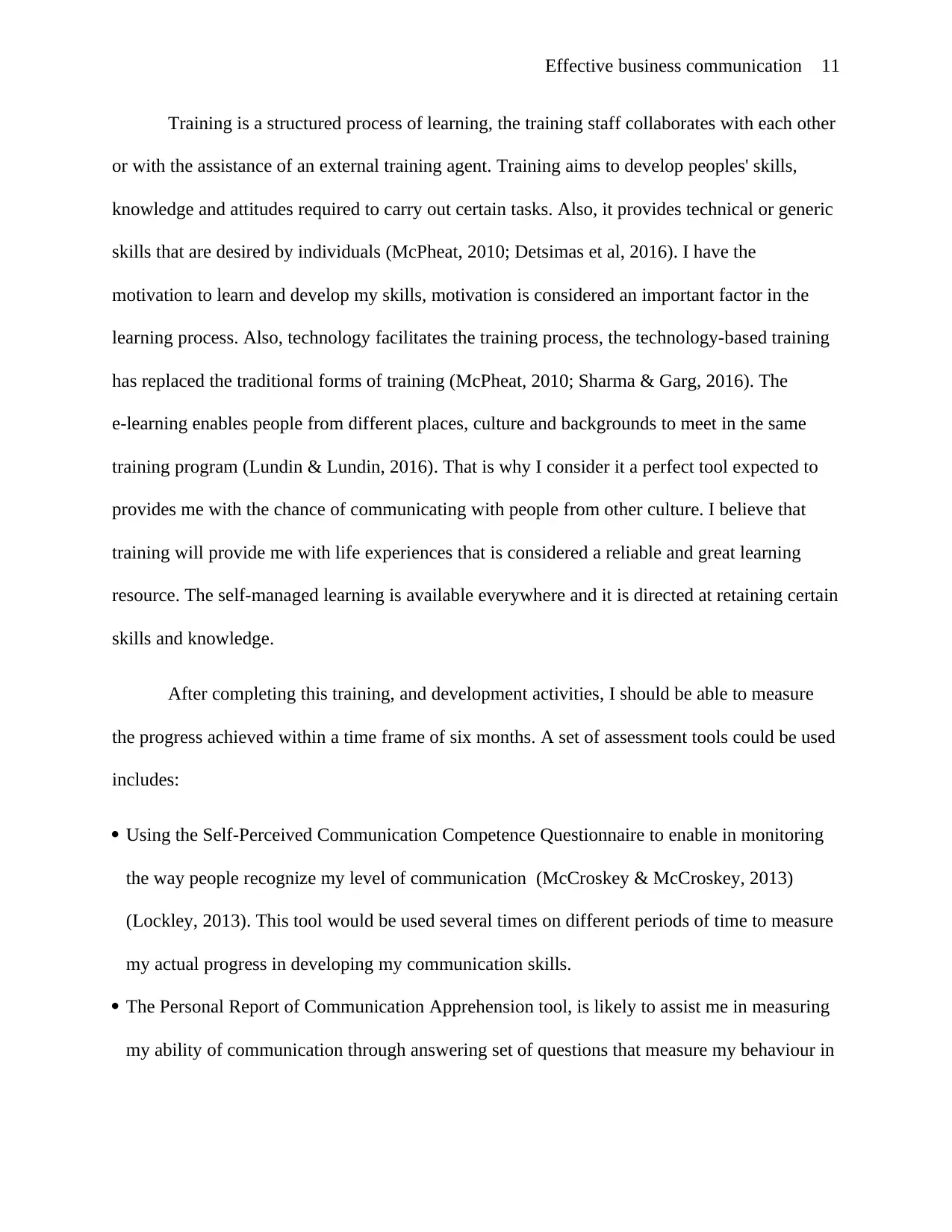
11Effective business communication
Training is a structured process of learning, the training staff collaborates with each other
or with the assistance of an external training agent. Training aims to develop peoples' skills,
knowledge and attitudes required to carry out certain tasks. Also, it provides technical or generic
skills that are desired by individuals (McPheat, 2010; Detsimas et al, 2016). I have the
motivation to learn and develop my skills, motivation is considered an important factor in the
learning process. Also, technology facilitates the training process, the technology-based training
has replaced the traditional forms of training (McPheat, 2010; Sharma & Garg, 2016). The
e-learning enables people from different places, culture and backgrounds to meet in the same
training program (Lundin & Lundin, 2016). That is why I consider it a perfect tool expected to
provides me with the chance of communicating with people from other culture. I believe that
training will provide me with life experiences that is considered a reliable and great learning
resource. The self-managed learning is available everywhere and it is directed at retaining certain
skills and knowledge.
After completing this training, and development activities, I should be able to measure
the progress achieved within a time frame of six months. A set of assessment tools could be used
includes:
Using the Self-Perceived Communication Competence Questionnaire to enable in monitoring
the way people recognize my level of communication (McCroskey & McCroskey, 2013)
(Lockley, 2013). This tool would be used several times on different periods of time to measure
my actual progress in developing my communication skills.
The Personal Report of Communication Apprehension tool, is likely to assist me in measuring
my ability of communication through answering set of questions that measure my behaviour in
Training is a structured process of learning, the training staff collaborates with each other
or with the assistance of an external training agent. Training aims to develop peoples' skills,
knowledge and attitudes required to carry out certain tasks. Also, it provides technical or generic
skills that are desired by individuals (McPheat, 2010; Detsimas et al, 2016). I have the
motivation to learn and develop my skills, motivation is considered an important factor in the
learning process. Also, technology facilitates the training process, the technology-based training
has replaced the traditional forms of training (McPheat, 2010; Sharma & Garg, 2016). The
e-learning enables people from different places, culture and backgrounds to meet in the same
training program (Lundin & Lundin, 2016). That is why I consider it a perfect tool expected to
provides me with the chance of communicating with people from other culture. I believe that
training will provide me with life experiences that is considered a reliable and great learning
resource. The self-managed learning is available everywhere and it is directed at retaining certain
skills and knowledge.
After completing this training, and development activities, I should be able to measure
the progress achieved within a time frame of six months. A set of assessment tools could be used
includes:
Using the Self-Perceived Communication Competence Questionnaire to enable in monitoring
the way people recognize my level of communication (McCroskey & McCroskey, 2013)
(Lockley, 2013). This tool would be used several times on different periods of time to measure
my actual progress in developing my communication skills.
The Personal Report of Communication Apprehension tool, is likely to assist me in measuring
my ability of communication through answering set of questions that measure my behaviour in
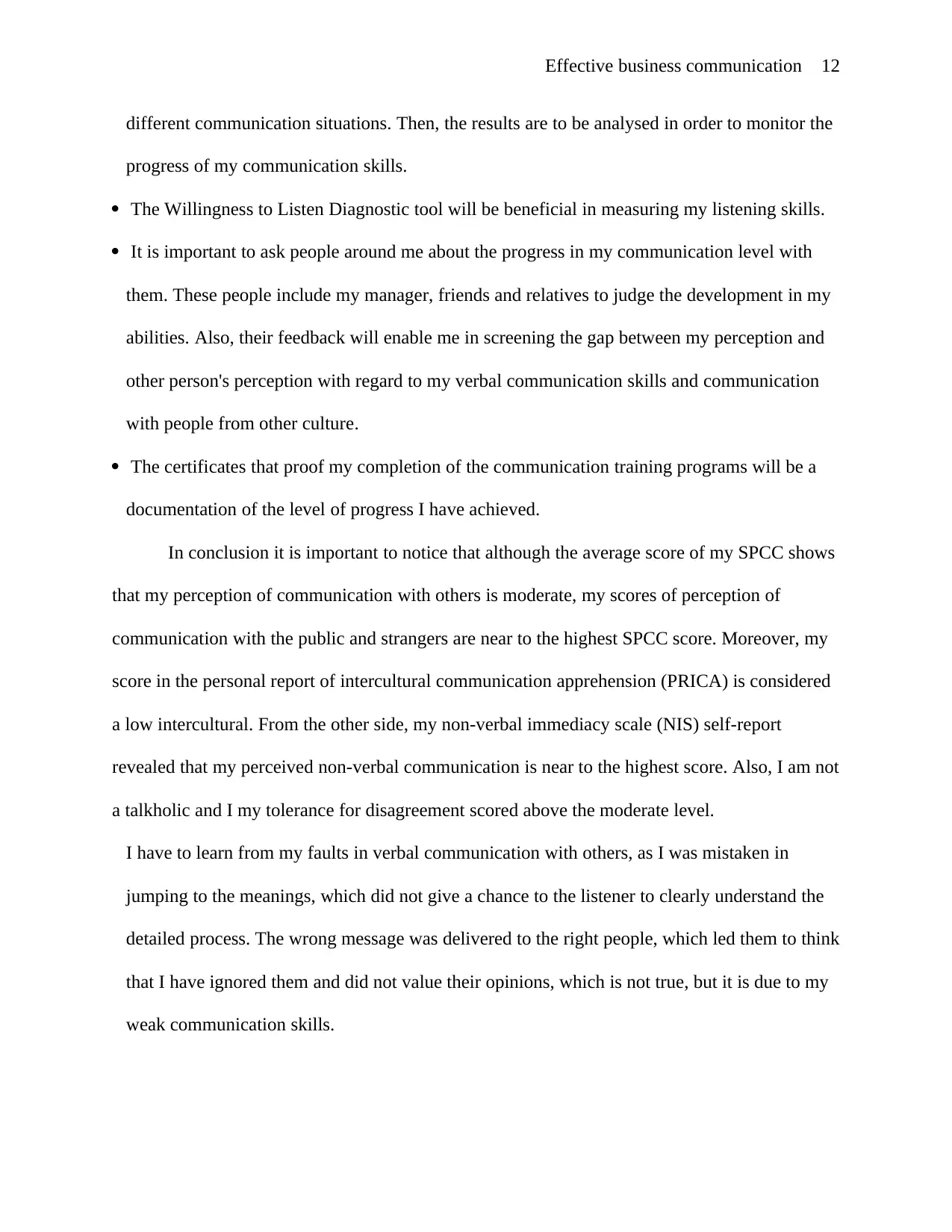
12Effective business communication
different communication situations. Then, the results are to be analysed in order to monitor the
progress of my communication skills.
The Willingness to Listen Diagnostic tool will be beneficial in measuring my listening skills.
It is important to ask people around me about the progress in my communication level with
them. These people include my manager, friends and relatives to judge the development in my
abilities. Also, their feedback will enable me in screening the gap between my perception and
other person's perception with regard to my verbal communication skills and communication
with people from other culture.
The certificates that proof my completion of the communication training programs will be a
documentation of the level of progress I have achieved.
In conclusion it is important to notice that although the average score of my SPCC shows
that my perception of communication with others is moderate, my scores of perception of
communication with the public and strangers are near to the highest SPCC score. Moreover, my
score in the personal report of intercultural communication apprehension (PRICA) is considered
a low intercultural. From the other side, my non-verbal immediacy scale (NIS) self-report
revealed that my perceived non-verbal communication is near to the highest score. Also, I am not
a talkholic and I my tolerance for disagreement scored above the moderate level.
I have to learn from my faults in verbal communication with others, as I was mistaken in
jumping to the meanings, which did not give a chance to the listener to clearly understand the
detailed process. The wrong message was delivered to the right people, which led them to think
that I have ignored them and did not value their opinions, which is not true, but it is due to my
weak communication skills.
different communication situations. Then, the results are to be analysed in order to monitor the
progress of my communication skills.
The Willingness to Listen Diagnostic tool will be beneficial in measuring my listening skills.
It is important to ask people around me about the progress in my communication level with
them. These people include my manager, friends and relatives to judge the development in my
abilities. Also, their feedback will enable me in screening the gap between my perception and
other person's perception with regard to my verbal communication skills and communication
with people from other culture.
The certificates that proof my completion of the communication training programs will be a
documentation of the level of progress I have achieved.
In conclusion it is important to notice that although the average score of my SPCC shows
that my perception of communication with others is moderate, my scores of perception of
communication with the public and strangers are near to the highest SPCC score. Moreover, my
score in the personal report of intercultural communication apprehension (PRICA) is considered
a low intercultural. From the other side, my non-verbal immediacy scale (NIS) self-report
revealed that my perceived non-verbal communication is near to the highest score. Also, I am not
a talkholic and I my tolerance for disagreement scored above the moderate level.
I have to learn from my faults in verbal communication with others, as I was mistaken in
jumping to the meanings, which did not give a chance to the listener to clearly understand the
detailed process. The wrong message was delivered to the right people, which led them to think
that I have ignored them and did not value their opinions, which is not true, but it is due to my
weak communication skills.
⊘ This is a preview!⊘
Do you want full access?
Subscribe today to unlock all pages.

Trusted by 1+ million students worldwide
1 out of 17
Related Documents
Your All-in-One AI-Powered Toolkit for Academic Success.
+13062052269
info@desklib.com
Available 24*7 on WhatsApp / Email
![[object Object]](/_next/static/media/star-bottom.7253800d.svg)
Unlock your academic potential
Copyright © 2020–2025 A2Z Services. All Rights Reserved. Developed and managed by ZUCOL.


